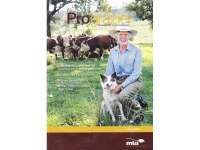Targeting performance with EBV's

1 June 2012
As a seedstock and commercial cattle producer, Kay Payne has used BREEDPLAN estimated breeding values (EBVs) for over 20 years to achieve genetic gains and track performance in her business, Elite Poll Herefords.
Kay has been performance recording since the late 1960s She began using BREEDPLAN to track and select for genetic gains in the early 1980s, as one of the initial experimental herds in the program.
At 'Eulalia' , Kay runs 350 commercial and registered breeders on native pastures oversown with sub clovers. Cattle must perform under these commercial production conditions,
so the focus for selection is on fertility, growth, milk and soundness.
Kay uses BREEDPLAN to target on-farm and market profit dri vers using the principles of producing offspring that go "from a vigorous calf, to a valuable carcase". Performance recording and EBVs enable optimisation of selected traits to meet the needs of seedstock clients and commercial markets.
"We know what characteristics our target markets require and, importantly, how to use these genetic selection tools to breed animals displaying those characteristics," Kay said.
Sires mainly come from Kay's seedstock herd. She uses artificial insemination to introduce genetics from other sources in Australia,
New Zealand or the USA that satisfy selection criteria for animal soundness, high fertility, calving ease (CE), quality, good temperament and carcase.
Calving ease
"First and foremost is the need for a healthy, live calf, so we look to use Poll Hereford sires with positive CE,
Kay Payne uses EBVs to target on-farm and market profit drivers.
both direct and maternal, and moderate birth weight," Kay said.
"Plus, we breed onl y from females that have a problem-free, regular, calving record."
Sires for heifers must have good growth and carcase traits for target markets and the gene pool. Kay regards her heifer's calves as her most valuable genetics source.
"We would like the resultant progeny to be in the top 20% of the breed
for 400-day growth and carcase, hence our heifer's calving ability is always challenged," Kay said.
However, contrary to the breed trend, Kay has selected genetics to avoid large increases in birth weights as the herd increases in other
growth traits. In the last 10 years,
the herd's birth weight EBV has increased by 0.5kg compared with the overall breed's increase of approximately 1.5kg.
"Our heifers can successfull y calve down 40kg+ progeny... proof that our calving ease selection and attention to management is working," Kay said.
Meeting markets
Kay's selection program also focuses on profit drivers directed by specifications for the European Union (EU), Meat Standards Australia (MSA) and short-fed feedlot markets.
For the MSA market, she uses BREEDPLAN to target genetics that achieve higher growth for age, (for lower ossification scores and so better boning groups); higher muscling (to improve yield, carcase weights and fat distribution) and higher intra muscular fat (to increase eating quality and achieve better boning groups) , in an animal that is structurally sound and has a good temperament.
Kay has increased carcase weights by selection for muscle. However, this has been managed carefully, so that the maintenance cost of breeders does not become excessive. Therefore, in terms of carcase weight, the herd is 1Okg ahead of the overall breed average but only 5kg ahead of the average in 600-day weight.
In 2009, average EBVs for her seedstock operation's annual sale were better than the breed's top 20%, and average Supermarket, Grass Fed and Grain Fed EU $Indexes were in the top 5% of the breed. By using EBVs to select for increased carcase muscling Kay produces steers and heifers that take advantage of these higher priced grids.
"Using BREEDPLAN, there is greater accuracy of genetic selection to achieve those traits," she said.
Published in the MLA's Prograzier Magazine, Autunm 2010 and reprinted in Charolais Magazine, Winter 2010.
